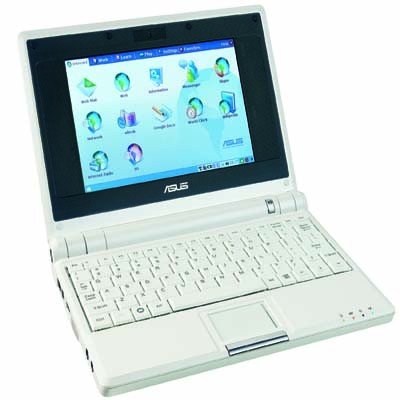skip to main |
skip to sidebar
I'm always on the lookout for OLPC alternatives for Africa. It's actually rather tricky, for the following reasons:
- You really need a low-powered device, something that can be powered by hand or via solar cells. This is because often in Africa the electricity isn't often reliable. Realistically a person could provide up to 466 Watts, so 15 minutes worth of effort can power a 50 Watt computer/display for up to 2.33 hours.
- You need a system which can survive extreme conditions. That's another reason why it needs to be low-powered, because low-power means cool.
- You need a system which uses pretty much off-the-shelf components: standard RAM, pretty much standard HDs.
- You need a system which is low maintenance. This pretty much rules out sending old second-hand PCs. There's 2 reasons for this: replacement parts are hard to find and computing expertise is hard to find.
- You need a system which has conventional interfaces: VGA, USB.
- You need a system which is very cheap. The $100 laptop is currently at roughly $200 which is realistic to donate in 10s of units (£1000).
- You need a system which is based on open source software, e.g Linux.
Not many computers fulfill these kind of criteria. One of them is the Asus eeePC.
Research machines are currently selling them for £169 each for the 2Gb version. However, they are for educational use only.
Another alternative is the FitPC. 
Assuming we have to pay the full whack of $285 (£150) this means we can put together a cheap developing country PC for around £260 (£85 lcd display, £150 machine, £10 keyboard/ mouse, £20 Hand crank PSU).
However we can probably cut this down somewhat. If we sell it through a charity on a non-profit basis we can probably do it for half the price: $143 (£72) and then get the rest of it ex-vat, we get: £72+£98 = £170 for the machines themselves (we'd then have to transport them).
Imperial measurements - what Americans call English measurements - really wind me up. I was born in the UK in the late 1960s and spent my childhood learning metric only to find that decades later most Brits (even ones much younger than me) still use imperial measurements for most normal things and still reuse the same arguments for their continued use.
And it's hard for me to switch over too. I've become used to thinking about liquids in litres (rather than pints or gallons), because petrol is bought in litres and UHT milk cartons / wine / water / fruit juice is too. Temperature is normally metric in the UK (so that's easy). And for a long time I've thought about short distances in metric and it's only in the past decade I've started to metricize the rest of my life.
And I mean, just normal things: I'm 1.7m tall and weigh 68Kg. My church (and my old place of work) is about 2Km away. Nottingham, where my parents live is just over 100km.
The real difficulty has been reading stuff in imperial on the web. Most of the world is metric, but most of the web is US-centric which means a lot of measurements are imperial even when they're technical. I kept finding this on Space.com: it's really wierd reading articles aimed at an international audience; about the latest space developments and seeing it all measured in pounds and feet, miles, farenheit and gallons. It's like - Nasa has been taken over by Torchwood!
So a few months ago I emailed one of the guys there and he wrote back to say:
“This is something you need to take up with the style of the major U.S.
syndicator of news: The Associated Press. We follow their style to be
consistent, and they dictate using only Fahrenheit.”
Yet just this week I noticed they'd changed to including metric measurements! Dave Mosher says they've updated their style guidelines, but it just goes to show that people can change their minds and be really considerate :-) !


